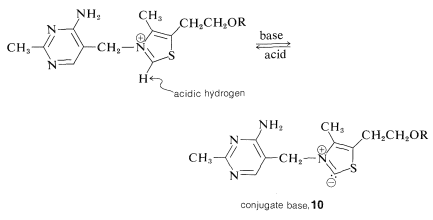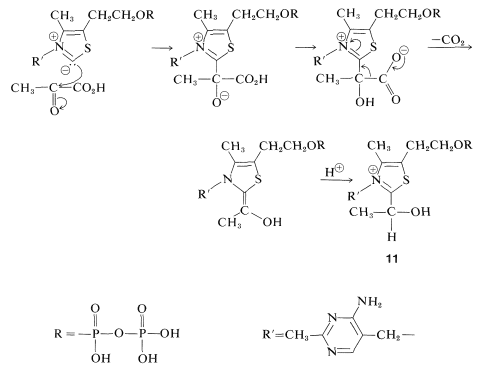25.10: Coenzymes
- Page ID
- 22366
Many enzymes only operate in combination with organic molecules that are actually reagents for the reaction. These substances are called coenzymes or cofactors. Some coenzymes function with more than one enzyme and are involved in reactions with a number of different substrates.
Several of the B vitamins function as coenzymes or as precursors of coenzymes; some of these have been mentioned previously. Nicotinamide adenine dinucleotide \(\left( \ce{NAD}^\oplus \right)\) which, in conjunction with the enzyme alcohol dehydrogenase, oxidizes ethanol to ethanal (Section 15-6C), also is the oxidant in the citric acid cycle (Section 20-10B). The precursor to \(\ce{NAD}^\oplus\) is the B vitamin niacin or nicotinic acid (Section 23-2). Riboflavin (vitamin B\(_2\)) is a precursor of flavin adenine nucleotide \(\left( \ce{FAD} \right)\), a coenzyme in redox processes rather like \(\ce{NAD}^\oplus\) (Section 15-6C). Another example of a coenzyme is pyridoxal (vitamin B\(_6\)), mentioned in connection with the deamination and decarboxylation of amino acids (Section 25-5C). Yet another is coenzyme A \(\left( \textbf{CoA} \ce{SH} \right)\), which is essential for metabolism and biosynthesis (Sections 18-8F, 20-10B, and 30-5A).
An especially interesting coenzyme is thiamine pyrophosphate (vitamin B\(_1\)) which, in conjunction with the appropriate enzyme, decarboxylates 2-oxopropanoic acid (pyruvic acid; Section 20-10B). We can write the overall reaction as follows:

Although we do not know just how thiamine binds to the enzyme, the essential features of the reaction are quite well understood. Thiamine has an acidic hydrogen at the 2-position of the azathiacyclopentadiene ring, and you should recognize that the conjugate base, \(10\), is both a nitrogen ylide and a sulfur ylide (Section 16-4A):

The acidity of the ring proton of the thiamine ring is a consequence of the adjacent positive nitrogen and the known ability of sulfur to stabilize an adjacent carbanion. Nucleophilic attack of the anionic carbon of \(10\) on \(\ce{C_2}\) of 2-oxopropanoic acid is followed by decarboxylation:

The overall reaction introduces a two-carbon chain at the \(\ce{C_2}\) position of the thiamine ring and the resulting modified coenzyme, \(11\), functions in subsequent biological reactions as a carrier of a \(\ce{CH_3-CHOH}-\) group and a potential source of a \(\ce{CH_3CO}-\) group. The metabolism of glucose (Section 20-10) requires the conversion of pyruvate to ethanoyl CoA by way of \(11\); and, in fermentation, the hydroxylethyl group of \(11\) is released as ethanal, which is reduced to ethanol by \(\ce{NADH}\) (see Section 15-6C for discussion of the reverse reaction).
Thiamine pyrophosphate also plays a key role in the biosynthetic reactions that build (or degrade) pentoses from hexoses. We have mentioned these reactions previously in connection with the Calvin cycle (Section 20-9) and the pentose-phosphate pathway (Section 20-10C).
Contributors and Attributions
John D. Robert and Marjorie C. Caserio (1977) Basic Principles of Organic Chemistry, second edition. W. A. Benjamin, Inc. , Menlo Park, CA. ISBN 0-8053-8329-8. This content is copyrighted under the following conditions, "You are granted permission for individual, educational, research and non-commercial reproduction, distribution, display and performance of this work in any format."


